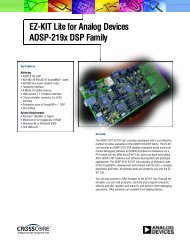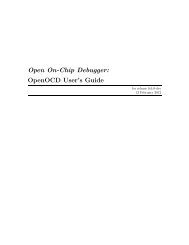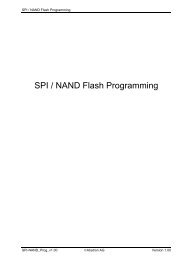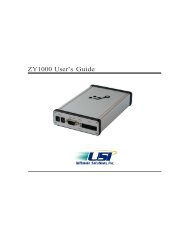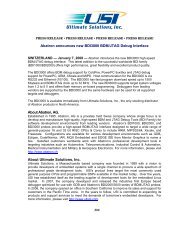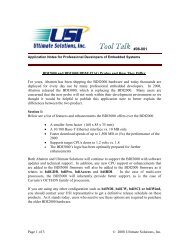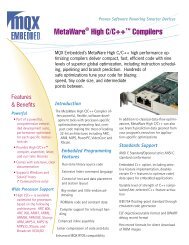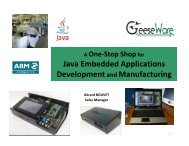STM32 Journal - Digikey
STM32 Journal - Digikey
STM32 Journal - Digikey
Create successful ePaper yourself
Turn your PDF publications into a flip-book with our unique Google optimized e-Paper software.
<strong>STM32</strong> <strong>Journal</strong><br />
compressed audio stream for<br />
decompression and signal<br />
processing (green)<br />
〉〉 Decompressed MP3 data is<br />
sent from the CPU to SRAM<br />
(yellow)<br />
〉〉 Audio data is output to I2S<br />
through DMA (orange)<br />
〉〉 Graphical icons are transferred<br />
from Flash to the display<br />
through DMA (blue)<br />
Communications Interfaces:<br />
Users want to be able to access<br />
audio data from different sources<br />
and over different interfaces.<br />
With the right mix of interfaces—<br />
including USB (host and device),<br />
Ethernet for Internet Radio,<br />
SDIO, and external memory—<br />
developers can create flexible<br />
devices that support a wide<br />
range of usage models.<br />
In addition to being able to<br />
receive data without loading<br />
the CPU, developers need to<br />
be able to address the many<br />
issues related to streaming<br />
audio, including lost packets and<br />
lack of feedback controls. For<br />
example, USB feedback controls<br />
to prevent under and overflow of<br />
the audio buffer are not always<br />
used or well implemented. This<br />
can result in lost or dropped<br />
packets that impact audio<br />
quality. To overcome this<br />
limitation, developers can utilize<br />
sample-rate conversion (SRC).<br />
SRC is also useful for converting<br />
between audio speeds (i.e., clock<br />
domains) while maintaining audio<br />
fidelity, compensating for slight<br />
mismatches in clock speed, or<br />
for mixing audio from different<br />
sources. For applications that<br />
need SRC, the <strong>STM32</strong> F4<br />
requires only 10% utilization,<br />
leaving plenty of headroom for<br />
other signal-processing tasks.<br />
Multiple Clock Sources:<br />
Consumer audio systems require<br />
a number of different clock<br />
domains—including the CPU,<br />
USB, and I2S—that have fixed<br />
frequencies and need to be<br />
accurate as well as free of jitter.<br />
Trying to use the same clock<br />
for each of these can impact<br />
precision. For example, it is<br />
straightforward to achieve a clean<br />
clock at 168 MHz for the CPU,<br />
44.1 KHz for an I2S interface or<br />
48 MHz for USB but not for all<br />
three using a single clock source.<br />
The <strong>STM32</strong> F4 integrates two<br />
PLLs for increased clocking<br />
flexibility. The main PLL is used<br />
to generate the system clock<br />
and the second PLL is available<br />
to generate the accurate clocks<br />
needed for high-quality audio.<br />
Complete audio system<br />
<strong>STM32</strong> F2<br />
CPU load<br />
<strong>STM32</strong> F4<br />
CPU load<br />
Flash<br />
footprint<br />
RAM<br />
footprint<br />
MP3 decoder 17% 6% 23k 12344<br />
MP3 encoder 22.5% 9% 25k 16060<br />
WMA decoder 17.5% 6% 45k 36076<br />
AAC+ v2 decoder 25% 11% 54k 87000<br />
Channel mixer 2.5% 2% 0.6k 16<br />
Parametric Equalizer 16% 12% 2k 300<br />
Loudness Control 4.5% 3.5% 3.25k 632<br />
SRC 22.5% 10% 17.5k 1880<br />
Figure 4 When computing 16- and 32-bit DSP functions, the<strong>STM32</strong> F4 offers a 25–70%<br />
improvement. As a result, systems can drop into sleep mode faster to conserve<br />
power or run more algorithms to further improve audio quality.<br />
In addition to being able to receive data<br />
without loading the CPU, developers need<br />
to be able to address the many issues<br />
related to streaming audio, including lost<br />
packets and lack of feedback controls.<br />
For example, USB feedback controls to<br />
prevent under and overflow of the audio<br />
are not always used or well implemented.<br />
15




